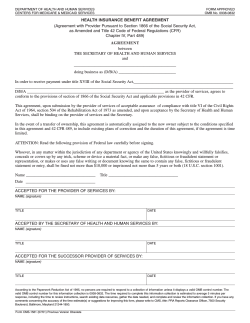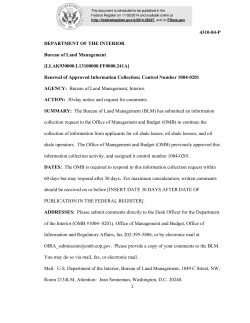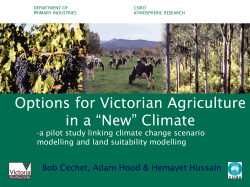
An Editorial Comment
HOW LONG HAVE WE BEEN IN THE ANTHROPOCENE ERA? An Editorial Comment With great interest we have read Ruddiman’s intriguing article which is in favor of placing the start of the Anthropocene at 5–8 millennia BP instead of the late quarter of the 18th century. He shows how land exploitation for agriculture and animal husbandry may have led to enhanced emissions of CO2 and CH4 to the atmosphere, thereby modifying the expected changes in the concentrations of these gases beyond those expected from variations in the Milankovich orbital parameters. Much of his argument depends on the correctness of their projected CH4 concentration curve from 7,000 years BP to pre-industrial times showing a decline to about 425 ppb, according to Milankovich, instead of the measured 700 ppb. It appears, however, strange that in Ruddiman’s analysis the proposed increase of CH4 due to anthropogenic activities stopped at about 1000 years BP, because ice core data showed almost constant mixing ratios of CH4 between 1000 years BP and about 200 years ago before the rapid rise of CH4 in the industrial period (IPCC, 2001). A major feature of Ruddiman’s argument is that natural atmospheric CH4 concentrations depend strongly on geological varying summer time insolations in the tropical northern hemisphere, controlling tropical wetlands and methane release from decaying organic matter under anaerobic conditions. The choice of the start of the anthropocene remains rather arbitrary. The records of atmospheric CO2 , CH4 , and N2 O show a clear acceleration in trends since the end of the 18th century. For that reason, the start of the anthropocene was assigned to about that time, immediately following the invention of the steam engine in 1784 (Crutzen and Stoermer, 2000; Crutzen, 2002). The consequences of this innovation have been astounding, for instance, there has been a tenfold rise in human population to 6000 million, during the past three centuries, and a fourfold increase in the 20th century (Turner et al., 1990; McNeill, 2000). This expansion was made possible by medical advances and a major growth in agriculture and animal husbandry leading for instance to a current cattle population of 1400 million (globally averaged about one cow per average size family). Let us give a few more examples. In a few generations mankind is exhausting the fossil fuels that were generated over several hundred million years, resulting in large emissions of air pollutants. The release of SO2 , globally about 160 Tg/year to the atmosphere by coal and oil burning, is at least two times larger than the sum of all natural emissions, occurring mainly as marine dimethyl-sulfide from the oceans (IPCC, 2001). The oxidation of SO2 to sulphuric and NOx to nitric acid has led to acidification of precipitation, causing forest damage and fish death in biologically sensitive lakes in regions, such Climatic Change 61: 251–257, 2003. 252 EDITORIAL COMMENT as Scandinavia and the northeast of North America. Due to substantial reductions in SO2 emissions, the situation has improved. However, the problem is now getting worse in Asia. From Vitousek et al. (1997) we learn that 30–50% of the world’s land surface has been transformed by human action, while the land under cropping has doubled during the past century at the expense of forests, which declined by 20% over the same period (McNeill, 2000). More nitrogen is now fixed synthetically and applied as fertilizers in agriculture than fixed naturally in all terrestrial ecosystems, 120 Tg/year vs 90 Tg/year (Galloway et al., 2002). The Haber–Bosch industrial process to produce ammonia from N2 in the air made the human population explosion possible. (It is amazing to note the importance of this single invention for the evolution on our planet.) Only 20 Tg N/year is, however, contained in the food which is consumed by humans. Wasteful application of nitrogen fertilizers in agriculture and especially its concentration in domestic animal manure have led to eutrophication of surface waters and even groundwater in many locations around the world. Fossil fuel burning adds another 25 Tg N-/year highly reactive NOx to the atmosphere, causing photochemical ozone formation in extensive regions around the globe. The additional input of altogether 145 Tg N/year is almost twice as large as the global natural biological fixation on land. The disturbance of the N cycle also leads to the microbiological production of N2 O, a greenhouse gas and a source of NO in the stratosphere, where it is strongly involved in stratospheric ozone chemistry. Human disturbance of the nitrogen cycle has recently been treated in a special publication of Ambio (Galloway et al., 2002). As a result of increasing fossil fuel burning, agricultural activities, deforestation, and intensive animal husbandry, especially cattle holding, several climatically important ‘greenhouse’ gases have substantially increased in the atmosphere over the past two centuries: CO2 by more than 30% and CH4 even by more than 100%, contributing substantially to the observed global average temperature increase by about 0.6 ◦ C that has been observed during the past century. The Intergovernmental Panel of Climate Change (IPCC, 1996) said in 1996: ‘The balance of evidence suggests a discernable human influence on global climate’ and in 2001: ‘There is new and stronger evidence that most of the warming observed over the last 50 years is attributable to human activities’ (IPCC, 2001). Depending on the scenarios of future energy use and model uncertainties, further emissions of CO2 and other greenhouse gases are estimated to cause a rise in global average temperature by 1.4–5.8 ◦ C during the present century, accompanied by sea level rise of 9–88 cm (0.5–10 m until the end of this millennium). The largest anthropogenic climate changes are still ahead for future generations. Furthermore, mankind also releases or have released many toxic substances in the environment and even some, the chlorofluorocarbon gases (CFCl3 and CF2 Cl2 ), which are not toxic at all, but which nevertheless have led to the Antarctic springtime ‘ozone hole’ and which would have destroyed much more of the ozone layer EDITORIAL COMMENT 253 if no international regulatory measures to end their production by 1996 had been taken. Nevertheless, due to the long residence times of the CFC gases, it will take at least until the middle of this century before the ozone layer will have largely recovered. The impact of humans on global economy and environment has undergone major stepwise expansions, especially during the second half of the past century. Figure 1 attempts to summarize the growing magnitude and changing nature of the Anthroposphere over the past 250 years in terms of changes in 12 key global-scale indicators. Note the distinct change in rate of increase of most indicators around 1950 and the sharp acceleration thereafter. The mid-20th century was a pivotal point of change in the relationship between humans and their life support system. Figure 2 shows the impacts of the changing Anthroposphere on the functioning of the Earth System as a whole. In many ways, not just in climate, the human impress on the global environment is clearly discernable beyond natural variability. All components of the Earth System – atmosphere, land, ocean, coastal zone – are being significantly affected by human activities. The period of the Anthropocene since 1950 stands out as the one in which human activities rapidly changed from merely influencing the global environment in some ways to dominating it in many ways: • Human impacts on Earth System structure (e.g., land cover, coastal zone structure) and functioning (e.g., biogeochemical cycling) now equal or exceed in magnitude many forces of nature at the global scale. • The rates of human-driven change are almost always much greater than those of natural variability. For example, the current concentration of atmospheric CO2 (about 90 ppmV higher that the pre-industrial level) has been reached at a rate at least 10 and possibly 100 times faster than natural increases in atmospheric CO2 concentration during the previous 420,000 years at least (Falkowski et al., 2000). • All of the changes to the Earth System depicted in Figures 1 and 2 are occurring simultaneously, and many are accelerating simultaneously. In summary, we conclude that Earth is currently operating in a no-analogue state. In terms of key environmental parameters, the Earth System has recently moved well outside the range of natural variability exhibited over at least the last half million years. The nature of changes now occurring simultaneously in the Earth System, their magnitudes and rates of change are unprecedented and unsustainable. We conclude that there may have been several distinct steps in the ‘Anthropocene’, the first, relatively modest, step can have been identified by Ruddiman, followed by a further major step from the end of the 18th century to 1950 and, from the perspective of the functioning of the Earth System as a whole, the very significant acceleration since 1950. Already in the 19th century, awareness of the upcoming human impact on the environment was identified among others by Marsh (1864) and further emphasized 254 EDITORIAL COMMENT Figure 1. The increasing rates of change in human activity since the beginning of the Industrial Revolution (Steffen et al., 2003). Significant increases in the rates of change occur around the 1950s in each case and illustrate how the past 50 years have been a period of dramatic and unprecedented change in human history. (U.S. Bureau of the Census, 2000; Nordhaus, 1997; World Bank, 2002; World Commission on Dams, 2000; Shiklomanov, 1990; International Fertilizer Industry Association, 2002; UN Centre for Human Settlements, 2002; Pulp and Paper International, 1993; MacDonalds, 2002; UNEP, 2000; Canning, 2001; World Tourism Organization, 2002). in particular by V. Vernadsky who wrote about 80 years ago: ‘The surface of the earth has been transformed unrecognizably, and no doubt far greater changes will yet come. . . ’ ‘. . . We are confronted with a new form of biogenic migration resulting from the activity of the human reason’. Let us thus hope that the fourth phase of the ‘anthropocene’, which should be developed during this century, will not be further characterized by continued EDITORIAL COMMENT 255 Figure 2. Global-scale changes in the Earth System as a result of the dramatic increase in human activity (Steffen et al., 2003): (a) atmospheric CO2 concentration (Etheridge et al., 1996); (b) atmospheric N2 O concentration (Machida et al., 1995); (c) atmospheric CH4 concentration (Blunier et al., 1993); (d) percentage total column ozone loss over Antarctica, using the average annual total column ozone, 330, as a base (Image: J. D. Shanklin, British Antarctic Survey); (e) northern hemisphere average surface temperature anomalies (Mann et al., 1999); (f) natural disasters after 1900 resulting in more than ten people killed or more than 100 people affected (OFDA/CRED, 2002); (g) percentage of global fisheries either fully exploited, overfished or collapsed (FAOSTAT, 2002); (h) annual shrimp production as a proxy for coastal zone alteration (WRI, 2003; FAOSTAT, 2002); (i) model-calculated partitioning of the human-induced nitrogen perturbation fluxes in the global coastal margin for the period since 1850 (Mackenzie et al., 2002); (j) loss of tropical rainforest and woodland, as estimated for tropical Africa, Latin America and South and Southeast Asia (Richards, 1990; WRI, 1990); (k) amount of land converted to pasture and cropland (Klein Goldewijk and Battjes, 1997); and (l) mathematically calculated rate of extinction (based on Wilson, 1992). 256 EDITORIAL COMMENT human plundering of Earth’s resources and dumping of excessive amounts of anthropogenic waste products in the environment, but more by vastly improved technology and environmental management, wise use of Earth’s remaining resources, control of human and of domestic animal population, and overall careful treatment and restoration of the environment – in short, responsible stewardship of the Earth System. References Blunier, T., Chappellaz, J., Schwander, J., Barnola, J.-M., Desperts, T., Stauffer, B., and Raynaud, D.: 1993, ‘Atmospheric Methane Record from a Greenland Ice Core over the Last 1000 Years’, J. Geophys. Res. 20, 2219–2222. Canning, D.: 2001, World Bank: ‘A Database of World Infrastructure Stocks, 1950–95’, World Bank, Washington, D.C. Crutzen, P. J.: 2002, ‘Geology of Mankind’, Nature 415, 23. Crutzen, P. J. and Stoermer, E. F.: 2002, IGBP Newsletter, No 41. Etheridge, D. M., Steele, L. P., Langenfelds, R. L., Francey, R. J., Barnola, J.-M., and Morgan, V. I.: 1996, ‘Natural and Anthropogenic Changes in Atmospheric CO2 over the Last 1000 Years from Air in Antarctic Ice and Firn’, J. Geophys. Res. 101, 4115–4128. Falkowski, P., Scholes, R. J., Boyle, E., Canadell, J., Canfield, D., Elser, J., Gruber, N., Hibbard, K., Högberg, P., Linder, S., Mackenzie, F. T., Moore III, B., Pedersen, T., Rosenthal, Y., Seitzinger, S., Smetacek, V., and Steffen, W.: 2000, ‘The Global Carbon Cycle: A Test of Knowledge of Earth as a System’, Science 290, 291–296. FAOSTAT: 2002, Statistical Databases, Food and Agriculture Organization of the United Nations, Rome, Available at: http://www.apps.fao.org, (12 August 2002). Galloway, J. N., Cowling, E. B., Seitzinger, S., and Socolow, R. H.: 2002, ‘Reactive Nitrogen: Too Much of a Good Thing?’, Ambio 31, 60–63. International Fertilizer Industry Association: 2002, Fertilizer Indicators, Available at: http://www. fertilizer.org/ifa/statistics/indicators/ind_cn_world.asp, (25 Oct 20002). IPCC: 1996, ‘Climate Change: The IPCC Scientific Assessment, Climate Change 1995’, in Houghton, J. T. et al. (eds.), Cambridge University Press. IPCC: 2001, ‘Climate Change 2001, The Scientific Basis, Contribution of Working Group 1 to the Third Assessment Request of the Intergovernmental Panel on Climate Change’, in Houghton, J. T. et al. (eds.), Cambridge University Press, Cambridge, U.K. and New York, N.Y., U.S.A., 881 pp. Klein Goldewijk, K., Battjes, J. J.: 1997, One Hundred Year Database for Integrated Environmental Assessments, National Institute for Public Health and the Environment (RIVM), Bilthoven, The Netherlands. Machida, T., Nakazawa, T., Fujii, Y., Aoki, S., and Watanabe, O.: 1995, ‘Increase in the Atmospheric Nitrous Oxide Concentration during the Last 250 Years’, Geophys. Res. Lett. 22, 2921–2924. Mackenzie, F. T., Ver, L. M., and Lerman, A.: 2002, ‘Century-Scale Nitrogen and Phosphorus Controls of the Carbon Cycle’, Chem. Geol. 190, 13–32. Mann, M. E., Bradley, R. S., and Hughes, M. K.: 1999, ‘Northern Hemisphere Temperatures during the Inferences, Uncertainties, and Limitations’, Geophys. Res. Lett. 26, 759–762. Marsh, G. P.: 1864, Man and Nature, reprinted in 1965 as The Earth as Modified by Human Action, Belknap Press, Cambridge, Massachusetts. McDonalds: 2002, Homepage, Available at: http://www.mcdonalds.com, (28 Oct. 2002). McNeill, J. R.: 2000, Something New under the Sun, W. H. Norton and Company, New York-London, 421 pp. EDITORIAL COMMENT 257 Nordhaus: 1997, ‘Do Real Wage and Output Series Capture Reality? The History of Lighting Suggests Not’, in Bresnahan, T. and Gordon, R. (eds.), The Economics of New Goods, University of Chicago Press, Chicago. OFDA/CRED: 2002, Emergency Events Database (EM-DAT): The OFDA (United States Office of Foreign Disaster Assistance)/CRED (Center for research on the Epidemiology of Disaster) international disaster database. Louvain Catholic University, Belgium, Available at: http://www.cred.be Pulp and Paper International: 1993, ‘PPI’s International Fact and Price Book’, in FAO Forest Product Yearbook 1960–1991, Food and Agriculture Organization of the United Nations, Rome. Richards, J.: 1990, ‘Land Transformation’, in Turner II, B. L., Clark, W. C., Kates, R. W., Richards, J. F., Mathews, J. T., and Meyer, W. B. (eds.), The Earth as Transformed by Human Action: Global and Regional Changes in the Biosphere over the Past 300 Years, Cambridge University Press, Cambridge, pp. 163–201. Shiklomanov, I. A.: 1990, ‘Global Water Resources’, Nature and Resources 26. Steffen, W., Sanderson, A., Tyson, P., Jäger, J., Matson, P., Moore III, B., Oldfield, F., Richardson, K., Schellnhuber, H.-J., Turner II, B. L., and Wasson, R.: 2003, Global Change and the Earth System: A Planet under Pressure. IGBP Global Change Series, Springer-Verlag, Berlin, Heidelburg, New York, in press. Turner II, B. L. et al.: 1990, The Earth as Transformed by Human Action, Cambridge University Press. UN Center for Human Settlements: 2002, The state of the world’s cities, 2001. United Nations, Available at: http://www.unchs.org, (4 Oct. 2002). UNEP: 2000, ‘Global Environmental Outlook 2000’, in Clarke, R. (ed.), United Nations Environment Programme. U.S. Bureau of the Census: 2000, International Database, Available at: http://www.census.gov/ ipc/www/worldpop.htm; Data updated 10 May 2000. Vernadsky, V.: 1986, The Biosphere, reprinted by Synergetic Press, Oracle AZ. Vitousek, P. M. et al.: 1997, ‘Human Domination of Earth’s Ecosystems’, Science 277, 494–499. Wilson, E. O.: 1992, The Diversity of Life, Allen Lane, the Penguin Press. World Bank: 2002, Data and Statistics, Available at: http://www1.worldbank.org/economicpolicy/ globalization/data.html, (4 Oct. 2002). World Commission on Dams: 2000, Dams and Development: A New Framework for DecisionMaking, The Report of the World Commission on Dams, Earthscan Publications Ltd, London and Sterling, VA. World Tourism Organization: 2002, Tourism Industry Trends, Industry Science Resources, Available at: http://www.world-tourism.org. (22 Oct. 2002). WRI: 1990, ‘Forest and Rangelands’, in A Guide to the Global Environment, World Resources Institute, Washington, D.C., pp. 101–120. WRI: 2003, A Guide to World Resources 2002–2004: Decisions for the Earth, A joint Publication with UN Development Program, UN Environmental Program, World Bank and World Resources Institute, Washington, D.C. Max Planck Institute for Chemistry, Mainz, Germany PAUL J. CRUTZEN and Royal Swedish Academy of Sciences, Stockholm, Sweden WILL STEFFEN
© Copyright 2025





















